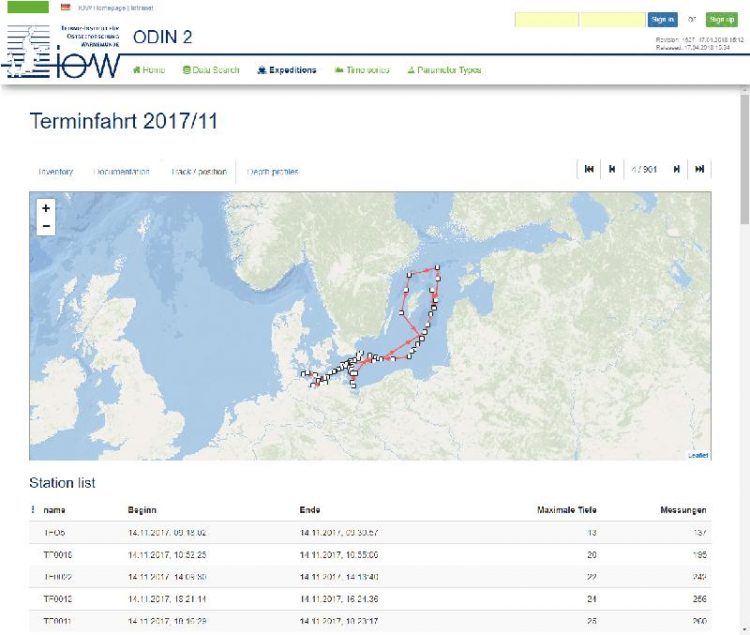Raising data treasures with ODIN 2 by easily surfing through over 60 years of Baltic Sea monitoring

More than 900 research trips and other Baltic Sea measurement campaigns are documented in the IOW database. With ODIN 2, the data of each individual trip can now be easily researched. IOW
Just like 50 years ago, the IOW will again go on five monitoring cruises this year, collecting data at stations that were already defined as reference points for the entire Baltic Sea research community five decades ago.
This is quite a long time span – and yet it can still be topped: In 1950, the GDR's Hydrographical Service was founded as the first oceanographic institution in Warnemünde. Soon after its opening, the regular monitoring cruises began. The first took place from December 27, 1951, to January 6, 1952.
What was measured at the time and how the data changed in the course of more than 60 years can still be researched in the IOW database today – for example, sudden salinity changes in the depths when, after a long period of stagnation, a strong saltwater inflow from the North Sea finally replaced the deep water of the Baltic Sea, or creeping changes in the times when oxygen was gradually depleted. Meanwhile, the data volume has grown to over 70 million entries.
Over 900 research cruises and other measuring campaigns have been documented. Routine recordings include the physical parameters temperature, salinity, oxygen and data on marine currents as well as various chemical parameters on the nutrient situation and pollutant load of the Baltic Sea.
The measuring programme also includes surveys on zooplankton and phytoplankton. This vast data set is of particular interest for the modellers among the Baltic Sea researchers, as such long-time observations not only provide an ideal basis for tracking down long-term trends, but also for extrapolating future scenarios to a wide variety of questions.
Since last year, this data treasure has been freely accessible and is equipped with a user-friendly research tool: ODIN 2 provides Internet-based access and additionally offers the automatic visualization of long-term data series for regularly measured parameters.
While external users without registration only have access to selected data sets (time series and depth profiles from the monitoring program), almost the entire contents of the IOW database is available with registration. The comfortable search is possible either in German or in English with any current web browser and can be customized for specific projects, stations, parameters, time periods, depths and/or areas.
ODIN 2 offers the possibility to choose between different output formats for the results and is also able to provide a permanent link for each individual search.
“This makes the data citable, because even after they have been included into comparative publications, it is still possible to trace where they originally came from,” emphasizes Susanne Feistel, who is responsible for data curation at the IOW.
“We have attached particular importance to an intuitive user interface. But we are also satisfied with the performance: For ‘normal’ searches, the system only takes seconds, rarely more than a minute,” adds Steffen Bock, the developer of ODIN 2.
Expert contact:
Dr. Susanne Feistel | Tel.: 0381 – 5197 456 | susanne.feistel@io-warnemuende.de
Dr. Steffen Bock | Tel.: 0381 – 5197 199 | steffen.bock@io-warnemuende.de
IT group at Leibniz Institute for Baltic Sea Research Warnemünde
Press and public relation:
Dr. Barbara Hentzsch | +49 381 5197-102 | barbara.hentzsch@io-warnemuende.de
Dr. Kristin Beck | +49 381 5197-135 | kristin.beck@io-warnemuende.de
IOW is a member of the Leibniz Association with currently 95 research institutes and scientific infrastructure facilities. The focus of the Leibniz Institutes ranges from natural, engineering and environmental sciences to economic, social and space sciences as well as to the humanities. The institutes are jointly financed at the state and national levels. The Leibniz Institutes employ a total of 19.100 people, of whom 9.900 are scientists. The total budget of the institutes is 1.9 billion Euros.
Dr. Susanne Feistel | Tel.: 0381 – 5197 456 | susanne.feistel@io-warnemuende.de
Dr. Steffen Bock | Tel.: 0381 – 5197 199 | steffen.bock@io-warnemuende.de
IT group at Leibniz Institute for Baltic Sea Research Warnemünde
Media Contact
More Information:
http://www.io-warnemuende.deAll latest news from the category: Earth Sciences
Earth Sciences (also referred to as Geosciences), which deals with basic issues surrounding our planet, plays a vital role in the area of energy and raw materials supply.
Earth Sciences comprises subjects such as geology, geography, geological informatics, paleontology, mineralogy, petrography, crystallography, geophysics, geodesy, glaciology, cartography, photogrammetry, meteorology and seismology, early-warning systems, earthquake research and polar research.
Newest articles

High-energy-density aqueous battery based on halogen multi-electron transfer
Traditional non-aqueous lithium-ion batteries have a high energy density, but their safety is compromised due to the flammable organic electrolytes they utilize. Aqueous batteries use water as the solvent for…

First-ever combined heart pump and pig kidney transplant
…gives new hope to patient with terminal illness. Surgeons at NYU Langone Health performed the first-ever combined mechanical heart pump and gene-edited pig kidney transplant surgery in a 54-year-old woman…

Biophysics: Testing how well biomarkers work
LMU researchers have developed a method to determine how reliably target proteins can be labeled using super-resolution fluorescence microscopy. Modern microscopy techniques make it possible to examine the inner workings…





















